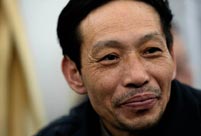 Int'l Snow Sculpture Art Expo in Harbin
Int'l Snow Sculpture Art Expo in Harbin Sichuan money wall for dividend payment
Sichuan money wall for dividend payment Li Na crashes Belinda Bencic in 2nd round at Australian Open
Li Na crashes Belinda Bencic in 2nd round at Australian Open
 Shocking moments when PLA's weapons open fire
Shocking moments when PLA's weapons open fire Famous Lanzhou beef noodles
Famous Lanzhou beef noodles Armed Police hold anti-terrorism drill in SE China's Xiamen
Armed Police hold anti-terrorism drill in SE China's Xiamen Harbin Int'l Ice and Snow Festival opens
Harbin Int'l Ice and Snow Festival opens 'Jin' named the word of the year by cross-strait netizens
'Jin' named the word of the year by cross-strait netizens Chinese scientific expedition goes to build new Antarctica station
Chinese scientific expedition goes to build new Antarctica station
Accompanied reeducation
In July 2008, Sunshine Midway House was established in Heihuzhuang, near the Beijing-Tianjin Expressway (S15), following successful international practice. The community correction center was designed to accommodate some 5,000 released prisoners from Chaoyang District in Beijing.
"These people had no residence or work. It was difficult to manage them," said Liu Yong.
Sunshine Midway House held study sessions every month. All the people subjected to community correction in the region had to attend in the company of police officers.
To ensure their human dignity, the house referred to the attendants as "trainees," to reflect a difference from prison practices. "The trainees and officers accompanying them had the same food, and lived in the same style dormitories," said Miao Jing, one of the police officers.
Miao said that the human touch of the house gave trainees the warmth they had missed while they were in prison. "Many people who may have looked rough on the outside later handed in heartfelt reports. It was very touching indeed," he said.
Tian Lei said that the environment in the house was "indeed good." He said the happiest thing had been being able to get a good night's sleep. He is now allowed to leave the house to re-familiarize himself with society. People in the house would even keep his supper if he returned late.
The trial at Sunshine Midway House proved successful. Starting from 2011, its model was extended to the whole of Beijing.
Serious but caring correction
While providing warmth to attendants, Sunshine Halfway House also needs to show due seriousness, because after all, community correction is still a form of penalty. A difficulty facing the house is how to balance its "sunshine" warmth and the severity needed in correction enforcement.
Their dilemma reflects a larger issue: that local justice departments were required to "provide both seriousness and warmth" in law enforcement, which is difficult in practice. "It's improper for one person to act two roles," Liu said.
The grass-root community correction centers have wanted to increase their "law enforcement power," according to Liu, who explained that the lack of such powers does not have to reflect the seriousness of the punishment. "For example, corrections centers do not have necessary police facilities to catch fugitives," he added.
There has also been pressure from the abolition of the labor camps, because "repeat offenders" were reassigned to community correction, which increased the burden on correction centers.
But in China, the relationship between community correction and education through labor is more complicated. Vice Minister of JusticeZhao Dacheng noted at a press conference earlier, "Community correction is part of the penal system. Its legal basis, application and procedures differ from those for labor camps."
His conclusions sent scholars into concern, because questions regarding who will accept the released forced laborers and how long they will be subjected to community correction, remain open.
"For us, an immediate concern is whether there will be a surge of people requiring correction following the abolition of the labor camps," said Liu Yong. "This does not yet seem to have been the case, maybe because the abolition was quite a recent thing."

 A 60-hour journey home
A 60-hour journey home Int'l Snow Sculpture Art Expo
Int'l Snow Sculpture Art Expo Highlights of China's air force
Highlights of China's air force Airline crew stage flashmob dance at Kunming airport
Airline crew stage flashmob dance at Kunming airport Top15 countries to retire to in 2014
Top15 countries to retire to in 2014 Hot supermodel's new photo album released
Hot supermodel's new photo album released Asia's heaviest box girder finishes 'rotation' in Wuhan
Asia's heaviest box girder finishes 'rotation' in Wuhan Completed facade of People's Daily new headquarters
Completed facade of People's Daily new headquarters Chinese-branded car passes North America standard safety test for the first time
Chinese-branded car passes North America standard safety test for the first time Li Na beats Bouchard to reach Australian final
Li Na beats Bouchard to reach Australian final  Explore the sources of PM 2.5
Explore the sources of PM 2.5 Highlights of Chinese airborne troops'exercises
Highlights of Chinese airborne troops'exercises  'Living in ice house' competition held in central China
'Living in ice house' competition held in central China  Chinese figure in Oscar nominations
Chinese figure in Oscar nominations  Top ten aerospace events in China 2013
Top ten aerospace events in China 2013Day|Week|Month